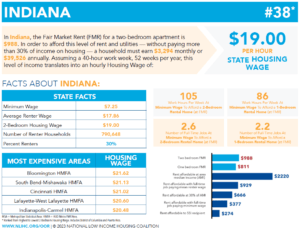 Full-time Hoosier workers need to earn $19.00 per hour to afford a modest, two-bedroom apartment at fair market rent. This is Indiana’s 2023 “Housing Wage,” according to a report published today by the National Low Income Housing Coalition (NLIHC) and Prosperity Indiana. The report finds that inflated rent in Indiana has fueled the increase in the state’s Housing Wage needed to afford housing costs, erasing any gains in Hoosier renters’ wages which remain persistently far below the Midwest average.
Full-time Hoosier workers need to earn $19.00 per hour to afford a modest, two-bedroom apartment at fair market rent. This is Indiana’s 2023 “Housing Wage,” according to a report published today by the National Low Income Housing Coalition (NLIHC) and Prosperity Indiana. The report finds that inflated rent in Indiana has fueled the increase in the state’s Housing Wage needed to afford housing costs, erasing any gains in Hoosier renters’ wages which remain persistently far below the Midwest average.
Released annually, the Out of Reach report calls attention to the gulf between wages and what people need to earn to afford their rents. The report shows that affordable rental homes are out of reach for millions of low-wage workers and other families. The report’s “Housing Wage” is an estimate of the hourly wage full time workers must earn to afford a rental home at fair market rent without spending more than 30% of their incomes. Nationally, the 2023 Housing Wage is $28.58 per hour for a modest two-bedroom rental home and $23.67 for a modest one-bedroom rental home.
While the Housing Wage varies by state and metropolitan area, low-wage workers everywhere – including in all 92 Indiana counties – struggle to afford their housing. “Indiana has twin crises of a shortage of affordable homes and too few good-paying jobs to afford them. This is a symptom of a lack of economic opportunity which prevents too many Hoosiers from achieving their true potential and leaves Indiana behind the curve of the Midwest,” said Andrew Bradley, policy director for Prosperity Indiana and board member of NLIHC.
“The new Out of Reach 2023 report finds that while the Housing Wage needed to afford a modest two-bedroom home in Indiana increased by 12% over the past year, the average Hoosier renter’s wage increased by only 7.5%. The report also finds that 10 of Indiana’s top 20 largest occupations now don’t pay the state’s Housing Wage, up from nine just a year ago. This double squeeze of low pay and out-of-reach housing disproportionately harms Black and brown Hoosiers, families with children, and the state’s most vulnerable populations in urban, rural, and suburban communities alike.”
